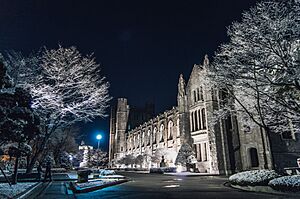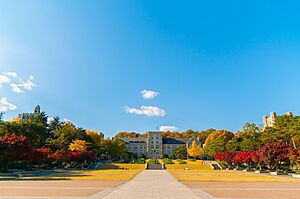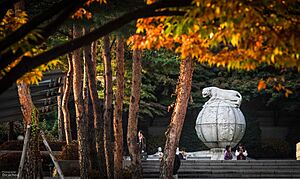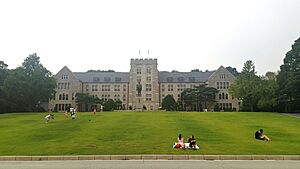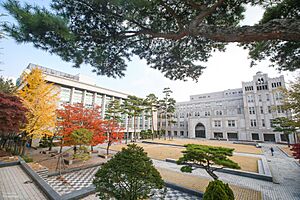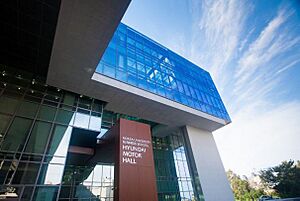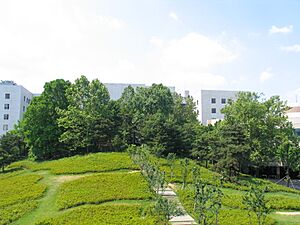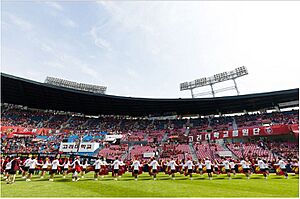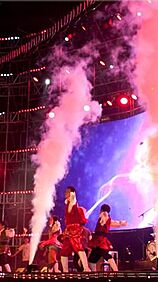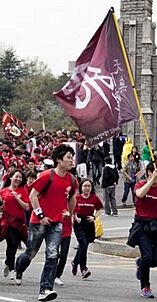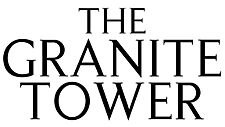Korea University facts for kids
|
고려대학교
|
|

Global Symbol of Korea University
|
|
|
Former names
|
Bosung College (1905–1946) |
|---|---|
| Motto | Libertas, Justitia, Veritas (Latin) 자유, 정의, 진리 |
|
Motto in English
|
"Liberty, Justice, Truth" |
| Type | Private research university |
| Established | 5 May 1905 |
|
Academic affiliations
|
APRU, U21 |
| President | Kim Dong-one |
|
Academic staff
|
4,443 (2024) |
|
Administrative staff
|
1,101 (2024) |
| Students | 31,130 (2024) |
| Undergraduates | 21,029 (2024) |
| Postgraduates | 10,101 (2024) |
| Location |
Seongbuk District, Seoul
,
South Korea
|
| Campus | Urban, 233.8 acres (94.6 ha) |
| Newspapers | Korea University Weekly The Granite Tower |
| Colors | Crimson |
| Nickname | Tigers |
|
Sporting affiliations
|
U-League |
| Mascot | Hwanho (Tiger) |
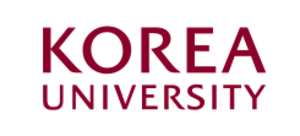 |
|
| Korean name | |
| Hangul |
고려대학교
|
| Hanja |
高麗大學校
|
| RR | Goryeo daehakgyo |
| MR | Koryŏ taehakkyo |
Korea University (KU, Korean: 고려대학교; RR: Goryeo Daehakgyo) is a private research university in Seoul, South Korea. It was started in 1905 as Bosung College by Lee Yong-Ik, an important official from the Korean Empire. Korea University is one of the oldest and first modern private universities in South Korea. It is named after Goguryeo, an ancient Korean kingdom. Korea University is known as one of the top three universities in the country, often called a "SKY university."
The university has over 20,000 undergraduate students and more than 10,000 graduate students. Korea University offers many programs, including liberal arts, social sciences, business, economics, and engineering. It has 81 departments across 19 colleges and divisions. There are also 22 graduate schools and 18 undergraduate schools. The university has libraries, a museum, and a press office. Over 1,500 full-time teachers work here, with most holding advanced degrees. More than 350,000 students have graduated from Korea University. The university also has another campus in Sejong City.
Korea University's sports teams are called the KU Tigers. They play in the U-League, which is South Korea's college sports league. The Tigers are very successful in sports like basketball, football, American football, ice hockey, baseball, and rugby. Many of these teams started in the early 1900s. They have won many national championships in different sports.
Contents
History
How it Started: Bosung College
Korea University began on May 5, 1905, as Bosung College. Lee Yong-Ik, who managed money for the Royal Family, started it with the idea that "Education Saves the Country." Emperor Gojong also supported it. The college first offered two-year programs in Law and Plutology (the study of wealth). Shin Hae-yeong was its first president. Classes were held in the old Russian Language School buildings. During the time Japan ruled Korea (1910–1945), Bosung College was a symbol of national pride.
In 1907, the programs became three years long and were renamed Law and Economy. The first students graduated that year. Bosung College grew, buying more buildings and starting academic magazines. In 1910, it changed its name to Bosung University. Later, in 1915, it became Bosung Law and Commerce College. This was to follow rules set by the Japanese government.
After Bosung College started, Lee Yong-Ik went into exile to fight against Japan. This caused money problems for the college. Sohn Byong-Hee, a leader of a nationalist movement, helped by taking over the college's management. In 1929, the college faced more money problems because of a worldwide economic downturn. Kim Seong-su helped solve this when he became president in 1932. In 1934, the main building was finished in Anam-dong. The library was built in 1935 to celebrate the college's 30th anniversary. It was finished two years later. In 1944, the Japanese government forced Bosung College to change its name and took control of it.
After Independence
After Korea became independent in 1945, Bosung College became Korea University in 1946. It had three colleges: Political Science and Law, Economics and Commerce, and Liberal Arts. The goal was to train talented people and develop Korean culture. Hyun Sang-Yun, the first president, bought more land to expand the campus. In 1949, Korea University gave out its first bachelor's degrees and started its graduate school. Yu Chin-O, the fourth president, continued to expand the university. He added a Science division and a College of Agriculture. Kim Seoung-su, who helped found the university, became the Vice President of the Korean Government. This helped Korea University grow even more.
During the Korean War, Korea University moved its classes to Daegu temporarily. It returned to Seoul after the war ended. The university added more departments and buildings. In the mid-1950s, the university grew to over 3,300 students. Important research centers were also started. Korea University created its official flag, emblem, and badge. It also brought back the Friendship Games against Yonsei University. Student life improved with new facilities.
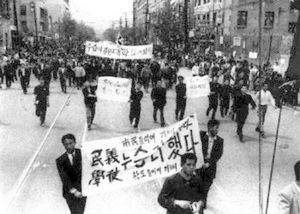
On April 18, 1960, about 3,000 Korea University students protested against the government of President Syngman Rhee. They were upset about unfair elections. The students marched to the National Assembly Building to ask for changes. On their way back, they were attacked by groups who supported the government. This event helped start the April Revolution the next day. Students and citizens across the country protested, which led to President Rhee stepping down. Every year, the university holds the 4.18 Marathon to remember the students' bravery. A monument honoring these students stands near the university's main square.
In 1961, the Liberal Arts building was finished. Other facilities like the museum and agriculture laboratory were also completed. The Science and Engineering Departments received new equipment. In 1963, the Graduate School of Business Administration, the first in Korea, was started. Yu Chin-O retired in 1965, and Lee Chong-Woo became the fifth president. After 1966, Korea University continued to grow, adding more departments in Science, Engineering, and Agriculture. The Graduate School of Education was also founded. New buildings like the General Education Building were added.
In 1971, Korea University merged with Woosuk University. This included Woosuk's colleges of Medicine, Liberal Arts, and Sciences, Law and Economics, and its hospital. In 1972, the Business Administration Building was completed. The College of Education was also established that year.
Growth and Modernization
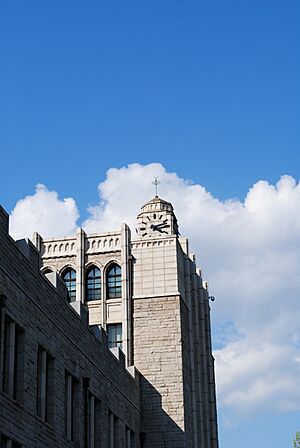
In 1975, Cha Rak-Hoon became the seventh president. In 1976, the College of Commerce was renamed the College of Business Administration. The Graduate School of Food and Agriculture was established in 1977. The College of Science and Engineering was split into two separate colleges: Science and Engineering. In March 1978, the new Central Library, which was the largest in South Korea at the time, opened.
In 1980, Korea University got approval to open a branch campus in Jochiwon (now Sejong City). The university dormitory also welcomed its first students. New departments were approved for the Jochiwon Campus. The Ice Hockey Training Center was built in 1980. In 1981, the Institute of Viral Diseases became a WHO Research Collaborative Institution. New education halls were built on the Jochiwon Campus. The Aegineung Student Union Building was completed. In 1982, Kim Jun-yeop became the ninth president. New departments like Japanese Linguistics and Spanish Linguistics were approved for the Jochiwon Campus.
In 1983, the Medical School and hospital were expanded and became the Korea University Medical Center. This included four new hospitals. The Science Library opened as a research center. New departments like Genetic Engineering and Computing Science were started. In 1984, new buildings for the College of Law and Political Science and Economics were built. The Research Institute of Sport Science was also founded.
In 1985, Lee Jun-beom became the tenth president. The university celebrated its 80th anniversary. New facilities like the Sports & Recreation Center were established. In 1986, new departments like Classical Chinese and Biological Engineering opened on the Jochiwon Campus. The Jochiwon Campus was renamed Seochang Campus in 1987. In 1988, new research institutes were founded. The Seochang Campus got a vice president. New education halls and departments were added. In 1989, new dormitories were built. Korea University also started working with the Korea Institute of Science and Technology (KIST).
New Discoveries and Progress
From 1990 to 1999, Korea University grew a lot and made many changes. New research centers were started for things like ICT, natural sciences, and biotechnology. New buildings like the Anam Hospital and several dormitories and libraries were built. KU also started graduate schools for international studies, journalism, and law. Many departments were renamed to include new study areas like environmental engineering and life sciences. The university partnered with many international universities.
In 2001, Korea University started a joint program with the University of British Columbia in Canada. The Korea University Lyceum was completed. In July, the Division of International Studies and the School of Journalism and Mass Communication were founded. In 2005, Korea University celebrated its 100th anniversary. The College of Life Sciences and Biotechnology was created by combining two colleges. The Junior College of Health Sciences also merged into the new College of Health Sciences.
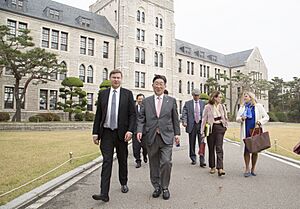
Korea University made big steps by starting the first Department of Artificial Intelligence in Korea. It also launched programs like the EURO-ASIA MBA. The university entered the top 100 private universities in the QS World University Rankings, reaching 69th place globally. Korea University was also the first in Korea to use a blockchain mobile ID system. It added a College of International Studies and reorganized the College of Pharmacy. Recently, Korea University celebrated its 120th anniversary. Dr. Kim Dong-One became the 21st president. The university's archives were added to UNESCO's Memory of the World Register. The new Anam Hospital Medicomplex was also completed.
Campus
Korea University's Seoul Campus is in the Seongbuk District of Seoul. It covers about 94 hectares (233.8 acres). The campus has three main areas: Humanities and Social Sciences, Natural Sciences, and a Green Campus. These areas are spread across the Anam-dong and Jongam-dong neighborhoods.
Humanities and Social Sciences Campus
This campus is in Seongbuk District and is home to many departments. These include the Law School, Business School, College of Liberal Arts, and College of Education. The buildings here are known for their stone architecture, which looks like old European university buildings. This style gives the campus a strong, fortress-like look.
Central Square is a large plaza with three underground floors. It was finished in 2002. This plaza is a central spot for students and staff. It has reading rooms, a library, a health center, and offices. The underground levels connect to other buildings like SK Future Hall. Next to the plaza is the Main Building. This six-story stone building was finished in 1934. It used to be classrooms but now holds the President's Office. It is a protected historical landmark.
The business section is in the eastern part of this campus. The LG-POSCO Building opened in 2005 to celebrate the university's 100th anniversary. It has six stories and includes lecture rooms, offices, and a digital library. The Sudang Digital Library has business resources like the Bloomberg terminal for watching global markets. Next to it is the KUBS Main Building, built in 1972. The Hyundai Motor Hall opened in 2013. It has five above-ground floors and four underground levels. It includes faculty offices, lecture rooms, and study rooms.
The Korea University Library started in 1905. It is one of South Korea's largest academic libraries. It has about 3.8 million books and over 1 million digital materials. It also has a large collection of rare books. The library system has special branches like the Haesong Law Library and the Science Library. The Graduate School Library was built in 1937 and is a historic site. The library uses modern technology like RFID to help students find books easily.
The Korea University Museum was founded in 1934. It has about 100,000 artifacts. These include items from history, art, and the university's own past. The museum has seven permanent exhibition halls. It holds important national treasures, like a celestial globe clock and a 19th-century painting of palaces. It also has the first draft of Korea's constitution. The museum shows artworks from famous classical and modern artists.
The Centennial Memorial Samsung Hall is a building that combines a museum and a digital library. It was built to celebrate the university's 100th anniversary. The museum part is open to the public, while the digital library is for students.
Media Hall is home to the College of Media & Communication. This building has 12 above-ground floors and 2 underground levels. It was finished in 2011. The underground floors have TV studios and student broadcasting rooms. Floors 1 to 6 are for the School of Media & Communication. They have lounges, reading rooms, and classrooms. Floors 7 to 10 are for the School of Art & Design, with studios and training rooms.
Natural Sciences Campus
The Natural Sciences Campus has Korea University's science and engineering departments. Unlike the stone buildings of the Humanities Campus, these buildings are modern. This campus includes the College of Science, College of Engineering, and College of Health Sciences. It is a center for science and technology research.
Hana Square is in the middle of this campus. It is a multi-purpose building with three underground floors. It was finished in 2006. The name "Hana" means "one" or "unity." It also recognizes the financial support from Hana Bank. The building is designed to be eco-friendly. It has classrooms, reading rooms, a fitness center, and cafes.
Aegineung is a green space on the Natural Sciences Campus. It is a symbolic park near the Science Library. It is located on a small hill where a historical burial site once stood. Cherry blossoms are common in the park.
Green Campus
The Green Campus is where Korea University's health and medical sciences are located. It is home to the College of Medicine and the College of Nursing. The Korea University Anam Hospital is also here. This campus was planned in 1969.
The university's College of Medicine started in 1938 as Kyoung-sung Women's Medical College. It merged with Korea University in 1971. In 1983, the Korea University Medical Center (KUMC) was formed. KUMC is a large medical institution with three hospitals and several research centers. It provides education, research, and patient care.
Near the student dormitories is the Hwajeong Gymnasium, also known as the Tiger Dome. It is a multi-purpose sports complex. It has courts for badminton, squash, and a fitness center. It is the home stadium for the Korea University basketball team. It was built to celebrate the university's 100th anniversary.
The Techno Complex is a ten-story building completed in 1996. It has offices, a videoconference room, and a cafeteria. It also houses the Korea University Research and Business Foundation.
The College of Science Building was finished in 1996 and updated in 2012. It has six above-ground floors. It contains administrative offices, faculty offices, classrooms, and many laboratories. It also has research organizations like the Institute for Basic Science. The building was made possible by Chung Ju-yung, the founder of the Hyundai Group.
Housing
Korea University offers on-campus housing near Gaeunsa-gil. This area has several dormitory buildings. The dorms are called "Anam Dormitory." They include the Student Dormitory, Frontier Hall, Gosi Building, and housing for international students. Each dorm has different rules and facilities.
For new students, dorm placement depends on admission scores or distance from home. However, space is limited, so many students live off-campus. Returning students can reapply based on their grades. For international students, Korea University has dedicated housing like the CJ International House and Anam Global House. A new dormitory for international students is also expected to open.
Organization
Colleges and Schools
Korea University has 59 academic departments and programs. These are organized into 17 colleges and schools:
- Law School
- Business School
- College of Liberal Arts
- College of Life Sciences and Biotechnology
- College of Political Science and Economics
- College of Science
- College of Engineering
- College of Medicine
- College of Education
- College of Nursing
- College of Informatics
- College of Health Science
- College of International Studies
- College of Media and Communication
- School of Art and Design
- Mechatronics
- School of Interdisciplinary Studies
Departments and Programs
- Law
- Business Administration
- Korean Language and Literature
- Philosophy
- Korean History
- History
- Psychology
- Sociology
- Classical Chinese
- English Language and Literature
- German Language and Literature
- French Language and Literature
- Chinese Language and Literature
- Russian Language and Literature
- Japanese Language and Literature
- Spanish Language and Literature
- Linguistics
- Life Sciences
- Biotechnology
- Food Bioscience and Technology
- Environmental Science and Ecological Engineering
- Food and Resource Economics
- Political Science and International Relations
- Economics
- Statistics
- Public Administration
- Mathematics
- Physics
- Chemistry
- Earth and Environmental Science
- Materials Science and Engineering
- Chemical Engineering and Biological engineering
- Civil, Environmental and Architectural engineering
- Architecture
- Mechanical Engineering
- Industrial Management Engineering
- Electrical Engineering
- Medical Science
- Education
- Physical Education
- Home Economics Education
- Mathematics Education
- Korean Language Education
- English Language Education
- Geography Education
- History Education
- Nursing
- Biomedical Engineering
- Biosystem and Biomedical Science
- Health and Environmental Science
- Health Policy and Management
- Computer Science and Engineering
- Cyber Defense
- Art and Design
- International Studies
- Media and Communication
- Interdisciplinary Studies
Interdisciplinary Programs
- Science and Technology Studies
- Liberal Arts and Law
- EML (Emerging Market & Latin America) Program
- Language, Brain & Computer
- Humanities and Creative Industry
- Global Leader for the East Asian Century
- Ecologic landscape
- Climate Change Program
- Medical Science and Engineering
- Financial Engineering
- Law and Public Administration
- PEL(Politics, Economics and Law)
- Cryptology
- Fashion Design and Merchandising
- Multicultural Korean Education
- Brain and Cognitive Sciences
- Software Technology & Entrepreneurship Program (STEP)
- Food Industrial Management
- Public Governance and Leadership
- Medical Convergence Engineering
- Convergence Security
- Information Security
- Social Welfare
- DMC (Digital Media Culture)
- Financial Derivatives Engineering
- GKS (Global Korea Scholarship) Major Convergence
President's Office and Administration
The President's Room at Korea University has several offices that help the president manage the university. These include the Office of the President, the Office of Planning & Budget, the Office of Management Strategy, and the University Audit Team.
The Office of the President helps the president with academic, administrative, and external tasks. The Secretariat manages the president's schedule and events.
The Office of Planning & Budget plans the university's future and manages its money. It creates long-term plans and handles the budget. It also checks how well the university is doing.
The Office of Management Strategy works to make the university run better. It helps with efficiency and long-term growth. This office supports making decisions based on data.
The University Audit Team is an independent group that makes sure everything at the university is fair and follows rules. They check offices, colleges, and other groups. They also give legal advice.
The Office of Research Audit, part of the audit team, checks research projects. It makes sure research money is used correctly and that ethical rules are followed.
Administration Offices
Korea University's administration has several offices. The Office of Academic Affairs handles faculty and educational matters. The Office of Student Affairs helps students with careers and counseling. The Office of General Affairs manages human resources and finances. The Office of Physical Resources takes care of buildings and safety. The Office of External Affairs handles fundraising and communications. The Office of Digital Information manages IT and data. The Office of Admissions handles student applications.
Presidents
| Principal | Years as Principal | Name of Institution; Notes | |
|---|---|---|---|
| 1 | Shin Hae-Young | May 1905 – November 1907 | Bosung College |
| 2 | Yu Seong-Jun | December 1907 – January 1908 | |
| 3 | Shin Hae-Young | February 1908 – January 1909 | |
| 4 | Jung Young-Taek | February 1909 – June 1910 | |
| 5 | Yun Ik-Seon | July 1910 – February 1919 | Korea under Japanese rule |
| 6 | Kim Sang-Ok | March 1919 – February 1920 | |
| 7 | Ko Won-Hun | March 1920 – October 1923 | |
| 8 | Huh Heon | November 1923 – July 1925 | |
| 9 | Park Seung-Bin | September 1925 – February 1920 | |
| 10 | Kim Seong-Su | March 1932 – April 1935 | |
| 11 | Kim Yong-Mu | June 1935 – April 1937 | |
| 12 | Kim Seong-Su | May 1937 – January 1946 | |
| President | Years as President | Name of Institution; Notes | |
| 1 | Hyeon Sang-Yun | August 1946 – October 1950 | Korea University; Ambassador to the United States |
| 2, 3, 4 | Yu Jin-Oh | September 1952 – October 1965 | President of the New Democratic Party
Member of the 7th National Assembly of South Korea |
| 5 | Lee Jong-Wu | October 1965 – September 1970 | Member of the 8th National Assembly of South Korea |
| 6 | Kim Sang-Hyup | October 1970 – April 1975 | 16th Prime Minister of South Korea
President of The Korean Red Cross |
| 7 | Cha Rak-Hun | June 1975 – June 1977 | President of Sookmyung Women's University |
| 8 | Kim Sang-Hyup | August 1977– June 1982 | |
| 9 | Kim Jun-Yeop | July 1982 – February 1985 | Once participated in an armed resistance (Gwangbok-gun) against the Empire of Japan. |
| 10, 11 | Lee Jun-Beom | March 1985 – July 1989 | Non Executive Director of Korea Electric Power Corporation |
| 12 | Kim Hui-Jip | June 1990 – June 1994 | Director of Korea Research Foundation |
| 13 | Hong Il-Sik | June 1994 – June 1998 | Consultant to Samsung and the Federation of Korean Industries |
| 14 | Kim Jung-Bae | June 1998 – June 2002 | President of the Academy of Korean Studies |
| 15 | Euh Yoon-Dae | February 2003 – December 2006 | Chairman of the Korean Academic Society of Business Administration and KB Financial Group |
| 16 | Lee Pil-Sang | December 2006 – February 2007 | Dean and Honorary Professor of Korea University Business School |
| 17 | Lee Ki-Su | February 2008 – February 2011 | Member of the Advisory Committee of the Constitutional Court of Korea
Member of The National Unification Advisory Council |
| 18 | Kim Byoung-Chul | March 2011 – February 2015 | Director of the Korea University Foundation |
| 19 | Yeom Jae-Ho | March 2015 – February 2019 | Member of the Advisory Committee of National Assembly Budget Office and Ministry of Foreign Affairs |
| 20 | Chung Jin-taek | March 2019 – February 2023 | Vice President of the National Academy of Engineering of Korea
Chairman of DGIST |
| 21 | Kim Dong-one | March 2023 – present |
Academics
How to Get In: Admissions
| JoongAng National | Domestic | 4 | |
|---|---|---|---|
| QS National | General | 3 | |
| THE National | General | 6 | |
| ARWU National | Research | 3–6 | |
| QS Asia (Asia version) |
General | 13 | |
| THE Asia (Asia version) |
General | =27 | |
| USNWR Asia | General | 67 | |
| ARWU World | Research | 201–300 | |
| QS World | General | 61 | |
| THE World | General | 189 | |
| USNWR World | General | =288 | |
Getting into Korea University is very competitive. For regular admission, students need very high scores on the South Korean College Scholastic Ability Test (CSAT). In 2016, only about 5% of applicants were accepted this way. For top programs like medicine or business, CSAT scores need to be in the top percentiles.
There are also "Early Admission" options. These look at high school grades, essays, interviews, and extracurricular activities. Some tracks require a nomination from your high school. Others focus on documents or written exams.
Korea University has had the highest regular admission scores among private universities in South Korea from 2022 to 2025. In 2025, its average CSAT scores for humanities and natural sciences were first among private universities. The university also ranked first in national exams for Foreign Service Officers and Technical Officials in 2024.
Money for School: Scholarships
Korea University offers many scholarships, fellowships, and awards. These are managed by the Korea University Foundation, which started in 1905. There are almost 245 different scholarships available. Over 11.5 billion won is given out to students. Nearly 90% of international students receive a scholarship. Scholarships are given based on things like financial need, academic success, and grades.
Rankings and Reputation
Korea University was ranked 61st in the world in the 2026 QS World University Rankings. In 2016–17, it was ranked 16th in Asia. In 2014, its programs in politics, economics, chemical engineering, and communications were all in the top 50 worldwide.
In 2003, over 15% of the people who passed the Korean bar examination were from Korea University Law School.
The business programs at Korea University have international certifications. This means they meet high global standards. In 2007, the Ministry of Education named Korea University as having the best MBA program in South Korea. In 2015, its Executive MBA program was ranked 27th in the world by the Financial Times.
From 2003 to 2006, Euh Yoon-Dae, a former president, made big changes. He required teachers to publish more research and increased classes taught in English. He also made sure core classes were taught by full-time teachers. He signed agreements with 172 universities overseas. Korea University also built new facilities like the Centennial Memorial Samsung Hall.
Research and Discovery
Korea University does a lot of research in many different study areas. It spends over 365 million USD on research and gets over 500 million USD in funding. The university has filed many patent applications and registered hundreds of patents. It also earns money from sharing its technology. Korea University often publishes in international journals and works with others on research.
The university has over 200 research units and more than 185 laboratories. They focus on things like artificial intelligence, biotech, and engineering. They work with companies and the government to develop new technologies.
Students from Around the World
About 6,500 international students attend Korea University. The university offers English degree programs in the College of International Studies. International students can also apply to other programs, though most classes are in Korean.
Korea University is working to make its campus better for international students. It is building a new dormitory for 450 students. The university also increased staff who speak English and Chinese to help international students. It offers courses designed to help international and Korean students interact.
In 2024, Korea University's president, Kim Dong-one, announced a plan to increase international students and teachers to 30% in five years. This is to help the university compete globally. The university is working to build relationships with schools in Latin America, Southeast Asia, the Middle East, and Africa. They have added bilingual signs, halal food options, prayer rooms, and AI-assisted lecture subtitles to help international students.
Athletics
Korea University is part of the Korea University Sports Federation (KUSF). Its men's football, basketball, baseball, and ice hockey teams play in the KUSF U-League. The university's mascot is the tiger, and its athletes are called "Tigers." Korea University has a long-standing sports rivalry with Yonsei University. They have annual "friendship games" in five team sports: football, basketball, baseball, ice hockey, and rugby. This tradition started in the 1940s.
Korea University has played an important role in developing sports in South Korea. Many of its sports programs have a rich history and have been very successful. The football team, started in 1923, helped modern sports grow in Korea. It produced famous national players. The rugby team, founded in 1929, played the first recorded rugby match in Korea. The baseball team, started in 1948, won its first college title in 1960. The basketball team, formed in 1929, won the first national tournament in 1931. The ice hockey team, established in 1939, won its first college division title in 1946.
Friendly Competition: Rivalry with Yonsei University
The rivalry between Korea University and Yonsei University is very famous in South Korea. These are the country's top two private schools. Every fall, they have an annual sports festival. Since 1956, the Korea–Yonsei University Friendship Games include five events: Football, Rugby, Baseball, Basketball, and Ice Hockey.
The rivalry started a long time ago. Yeonhee College (now Yonsei University) and Boseong College (now Korea University) played against each other in soccer games in the 1920s.
Student Life and Culture
Clubs and Groups
Korea University has student unions and councils that represent students. There are over 80 student clubs and groups on campus. These clubs are divided into 10 categories: Social Science, Exhibition and Creative Art, Social Studies, Art, Religion, Language Studies, Life Culture, Sports, Literary Art, and Science and Technology. There is also a Foreign Students' Union to help international students.
Some examples of clubs include:
- Social Science: Philosophy Village, UNSA (UN Student's Association).
- Art: Korea University Choir, KU Orchestra, Korea University A Cappella Group LoGS.
- Sports: Fencing Club, Amateur Soccer Team, Skin Scuba Diving.
The Center for Human Rights and Gender Equality works to protect students' rights. It offers education on human rights and gender issues. The center investigates problems, provides counseling, and helps victims. It also has a Supporters Program where students promote equality on campus.
Traditions
The Granite Tower Festival (Seoktap Daedongje) is the biggest annual event at Korea University. It happens every year around May 5, which is the university's founding day. The festival started in 1962. During this week-long celebration, students, teachers, alumni, and local residents come together. All colleges, departments, and clubs take part. There are academic discussions, a broadcasting festival, and a lively street festival. Each night, famous performers entertain the crowd. The festival ends with Ipselenti Jiya, a popular cheering festival. Students gather to sing cheers, dance, and watch performances by Korean artists.
The April 18 Marathon (418 민주대장정) honors students who were attacked on April 18, 1960. On that day, 3,000 Korea University students protested peacefully against unfair elections. The government sent groups to stop the protest, hurting many students. Korea University students are proud of their role in Korean history. The marathon is a way to honor those who fought for a better future.
Ipselenti - Cry of "Ji Ya" (입실렌티- 지.야의 함성) is a cheering festival. It is held by the Korea University Cheerleaders on the last night of the Granite Tower Festival. Students gather to sing cheering songs and dance. Famous singers are often invited to perform. "Ipselenti" is part of Korea University's slogan. "Ji" and "Ya" mean wisdom and wildness.
News and Publications
The Korea University Weekly was first published in 1947. It is the longest-running college newspaper in South Korea. Students produce it weekly. It shares ideas from students, teachers, and staff on social issues.
The Granite Tower is Korea University's only English-language newspaper. It is one of the oldest English college publications in South Korea, started in 1954. It became a magazine in 1993. It covers current events and university news.
The Korea University Business School Journal started in 1960. It is South Korea's first and longest-running business publication. It shares news and information about the Business School.
Education News has been published since 1975 by the Korea University Graduate School of Education. It is a special academic journal about education. It shares research articles, teaching methods, and news about the education community.
Getting Around: Transportation
Korea University has a shuttle bus on its Seoul campus. It runs on weekdays during school semesters. The shuttle connects buildings, dorms, and other campus facilities. You can reach the campus by Seoul Subway Line 6 at Anam Station and Korea University Station. Airport Limousine Bus 6102 goes directly to Incheon International Airport. Other city buses also serve the campus.
School Song
Korea University's school song plays daily at 9 AM from the clock tower of the College of Liberal Arts building. The song was introduced in May 1955 for the university's 50th anniversary. The lyrics were written by Ji-Hoon Cho, a KU professor. The music was composed by Isang Yun. For the university's 100th anniversary, a symphony called "Symphony for Liberty, Justice and Truth" was composed by Alexey Larin. It was first performed by the Korea University Orchestra in 2005.
Student Body
Korea University's students come from many different backgrounds. They have different races, ethnicities, genders, and cultures. The university values these differences. It works to make diversity a part of its academic and administrative functions.
In 2022, Korea University checked 42 of its rules to make sure they supported diversity. The goal was to find and fix any rules that were not sensitive to diversity.
The university offers many courses about diversity. A core course called “Diversity in a Global Society” is taught in English. Twenty-four courses are marked as “D-class” for diversity electives. Students also participate in programs to promote diversity.
The university held a symposium to encourage diverse research. It publishes a monthly booklet called “Diversitas” in English and Chinese. It also holds events to promote diversity. The first Diversity Award was given to groups and people who support diversity.
For 2023, the university planned to have diversity officers in departments. It also planned to use diversity criteria in admissions and hiring. It aimed to expand diversity courses and create a diversity fund. The university also planned to work with other schools on diversity.
Notable People and Alumni
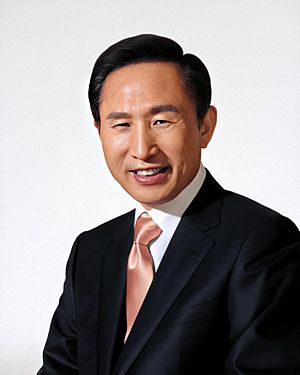
In 2009, Korea University had about 280,000 living graduates. Many famous lawyers, doctors, engineers, researchers, and Olympic athletes have graduated from Korea University. The university has produced many well-known politicians. These include Lee Myung-bak, the tenth president of South Korea, and Chung Sye-kyun, the 20th Speaker of the National Assembly. A survey of South Korea's top 500 companies showed that Korea University has produced the most CEOs for these companies.
Kim Seong-su, who founded Korea University, also helped create a close relationship between Korea University and Waseda University in Japan. This partnership started in 1973. Since the 2010s, they have offered special dual degree programs. This means students can earn degrees from both universities.
Korea University Sejong Campus
|
고려대학교 세종캠퍼스
|
|
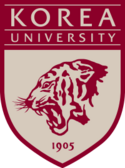 |
|
| Type | Private |
|---|---|
| Established | 1980 |
|
Academic staff
|
262 full-time 361 part-time (2018) |
| Students | 7,240 (2018) |
| Undergraduates | 6,483 (2018) |
| Postgraduates | 757 (2018) |
| Location |
Sejong
,
South Korea
|
| Campus | Suburban, 105 acres (42 ha) |
| Colors | Crimson |
| Mascot | Tiger |
| Website | sejong.korea.ac.kr |
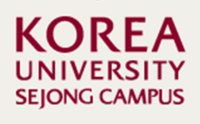 |
|
| Korean name | |
| Hangul |
고려대학교 세종캠퍼스
|
| Hanja |
高麗大學校 世宗캠퍼스
|
| RR | Goryeo daehakgyo Sejong kaempeoseu |
| MR | Koryŏ taehakkyo Sejong k'aemp'ŏsŭ |
Korea University Sejong Campus (고려대학교 세종캠퍼스; Goryeo Daehakgyo Sejong Kaempeoseu) is Korea University's second campus. It is in Sejong City, which is an important administrative city in South Korea. The campus officially opened in 1980. It is a leading research-focused campus. It includes the Biomedical Campus and a New Research Campus. Six colleges and schools at the Sejong Campus are part of Korea University.
Academics
Colleges and Schools
- College of Global Business
- Division of Convergence Business
- College of Public Policy
- College of Science and Technology
- College of Business and Economics
- School of Public Administration
- School of Sports and Leisure Studies
- College of Pharmacy
- Division of Smart Cities
Images for kids
See also
 In Spanish: Universidad de Corea para niños
In Spanish: Universidad de Corea para niños
- Association of Pacific Rim Universities
- Education in South Korea
- KU-Yonsei rivalry
- List of universities in Seoul
- List of colleges and universities in South Korea
- List of Korea University people
- SKY Universities
- S3 Asia MBA – Joint MBA program by Fudan University, Korea University and NUS Business School
- Universitas 21


